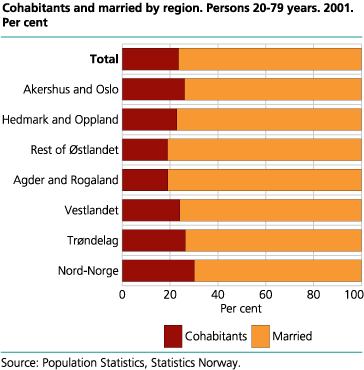Content
Published:
This is an archived release.
...Not either-or - but first-then
In all age groups except among persons between 20-29 years of age, being married is more common than living in cohabitation. In most cases, cohabitation is not a permanent alternative to marriage, although a majority prefer to start as cohabitants.
In 2001, 16 per cent of people aged 20-79 were cohabitants and 53 per cent were married. 31 per cent were neither cohabiting nor married at the time of the interview. The figures are based on annual interview surveys conducted by Statistics Norway.
Marriage has still a strong position
Another way of calculating the percentage of cohabiting couples is to exclude those not living as a couple, counting only the proportion cohabiting among those couples who are either cohabiting or married. Calculated in this way, 23.5 per cent of people aged 20-79 were cohabiting. Only for those 20-29 years, cohabitation was the most common form of union, 70 per cent were cohabiting and 30 per cent married.
The mean age of cohabiting men (20-79 years) was 36.8 years, compared to 51.6 years for those who were married. Comparable figures for women were 34.5 years and 48.6 years respectively.
Cohabitation most common in Northern Norway
Although cohabitation is widespread all over Norway, there are distinct regional differences. In Northern Norway, 30 per cent of all couples are cohabiting compared to one fifth in the regions where cohabitation is least widespread, the southern parts and some counties of the central region.
Few are living apart together (LATS)
In 2001, Statistics Norway for the first time also tried to measure so called living apart together (LATS). To end up in this category, the persons interviewed had to classify their relationship as marriage-like, although they were not living together. 8 per cent of a representative sample of 355 persons not married or cohabiting classified themselves as living apart together. The reasons for not living together varied greatly. Some said they wanted more freedom, some considered their relationship to be too new, and some were living different places due to work.
Tables:
Contact
-
Ane Margrete Tømmerås
E-mail: ane.tommeras@ssb.no
tel.: (+47) 91 99 29 62
-
Anders Sønstebø
E-mail: anders.sonstebo@ssb.no
tel.: (+47) 46 66 37 74
-
Statistics Norway's Information Centre
E-mail: informasjon@ssb.no
tel.: (+47) 21 09 46 42

